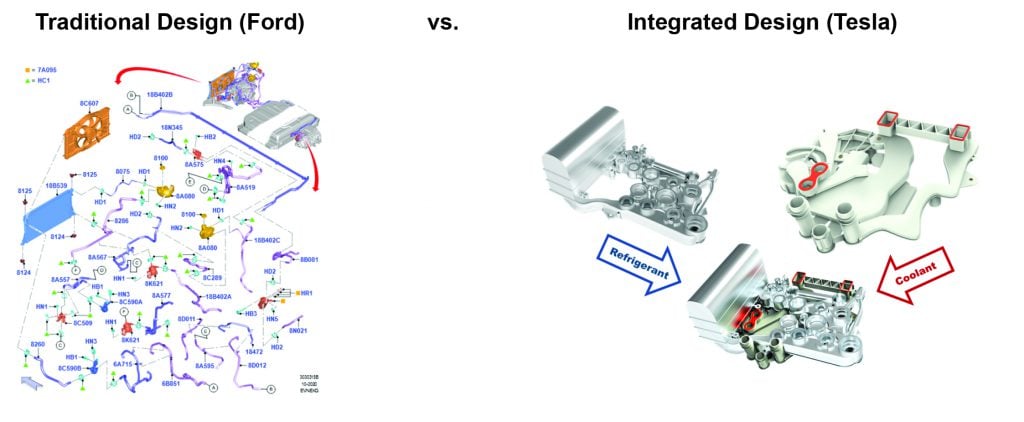Fluid Management Systems are Strategically Important for EV Manufacturers
FEBRUARY 16, 2022
Ford’s Electric Vehicle development shift highlights the importance of fluid management systems for future EV designs. Changing thermal/fluid system designs are an important part of improving range, charging speed, and passenger comfort as well as reducing mass on the order of 2kg or more and supporting EV cost reductions on the order of $1000. Furthermore, Ford realizes that it can’t wait for a minor platform refresh date, they must “reengineer the vehicle now” as a running change, as explained by Ford’s CEO Jim Farley.

Tesla’s Design Integration and Updates set the Benchmark For Competitors
Tesla has developed a different model for vehicle changes in general, and thermal/fluid management changes specifically. This is fundamentally different than major and minor refreshes when model years change, that traditional automakers have long perfected. Since day one, Tesla has organized to implement rapid changes in hardware and software design.
Thermal management and other software updates have been pushed to Tesla vehicles regularly using over-the-air (OTA) updates. OTA updates started with simpler infotainment updates but have migrated to higher functionality to improve vehicle performance such as automated driving features, charging time, and range. OTA updates are being used to improve the reliability of thermal systems and even to address thermal system recalls. Other automakers, like Audi and Porsche, have started using OTA software updates for thermal/fluid and other functions to improve range and charging time. Now it appears to be the stated goal of most automakers to make regular software updates for EVs, and even conventional vehicle models.
Tesla has also made more significant thermal/fluid hardware changes. The changes may not be called refreshes, but they may involve vehicle recertification especially if they improve the certified vehicle range. For example, the heat pump system designed for the Model 3/Y was implemented as a running change on the Model 3, less than one year after the launch of the Model Y.
Traditional OEMs, like Ford, Need to Make Cultural and Organizational Changes
In February 2022, Ford announced that it had found $1000 of cost-saving potential for the Mach-e. Furthermore, Ford will start making hardware, and software changes as soon as they are ready without being accumulated in a coordinated refresh. As Jim Farley, Ford’s CEO, stated:
“what we’re finding in Mach-E is that actually most of the exciting work starts after job one. That’s when the OTAs really make a customer impact.”
The “cooling system for Mach-E, it has four motors (pumps), probably needs to be two. It has 60 or 70 hoses, probably needs to be one-third of that. And we are not going to wait for next year. We’re not going to wait for a minor change. We are going to reengineer that vehicle now and then use that expertise for Lightning, E-Transit” and other models.
These changes by Ford are significant and, without knowing the exact design, ITB estimates that Ford can reduce mass by over 2kg and cost on the order of $70 by changing the Mach-e coolant system. For vehicles with complicated refrigerant and coolant systems, ITB estimates a difference of over 7kg and $250 between low-cost and high-cost multiple-source heat pump designs.
Many automakers are in the same boat as Ford. EV designs may use preexisting standards and practices instituted for conventional vehicle design which are based on economics applying to a wide range of powertrain and platform variants. Furthermore, Ford cautiously assumed a low volume approach for the Mach-e which didn’t support large investments in engineering to integrate components. Tesla’s best-in-class, high-volume, integrated design approach makes Tesla an EV piece cost, and system cost, leader.
Making these significant vehicle design improvements requires cultural and organizational changes at traditional automotive OEMs. Competing in the EV space is not business as usual. Companies must think big, and they must design lower cost, lower mass, integrated solutions. Automakers can’t rest and must continuously implement improvements in software and hardware.
ITB Provides Insights into Changing Vehicle Thermal/Fluid System Technologies and Markets
ITB surveys OEMs and companies throughout the automotive value chain to understand unmet needs and innovations for improved value. In our 2022 research, ITB will be diving deeply into designs and materials for fluid architectures, pumps, valves, lines, manifolds, and fluid connections. This will include differences across global regions, vehicle powertrain types, and OEMs. Contact The ITB Group to learn more about changing technology markets and to influence fluid systems research.
Interested in ITB's newly published Fluid Control and Conveyance for Electrified Vehicles report?



